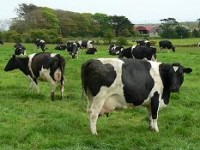The weather looks to be improving after the long spell of wet and cold weather. For the near future at least the outlook is for good drier weather with a decent amount of wind which should help drying conditions.
There is a lot of pressure on farmers now to get fields grazed to allow for slurry application and general fertiliser spreading. This pressure is going to result in some difficult decisions to be made regarding when to go into certain fields and with what stock.
Teagasc maintain and they are probably right that one of the main keys to profitability on farm is “How much grass you can grow on your farm”. The top farms in the country can grow 14 tons per hectare while the average in the country is only 8 tons. How do we grow more grass, long-term economically.
Most of us are after spending a lot of money on re-seeding ground in the last few years. The key to keeping these fields fertile and productive is to try to maintain the soil structure as best we can. Travelling wet fields with heavy machinery is a well-known cause of soil compaction which destroys soil structure and takes years to correct. Another less appreciated but equally harmful cause of serious soil structure damage is caused by Animals travelling on soil that is not dry enough to support them. After the recent long spell of wet weather the population of beneficial micro organisms is very low due to land being waterlogged. The earthworm population is indicative of this.
Take 5 minutes as an experiment on your own farm soil structure. Pick a couple of areas at random across your farm and dig a 12 inch square hole about 12 inches deep. Count the number of Earthworms that you find? If you had excellent soil fertility you could expect to find up to 20 Earthworms. From testing this across our customers we are finding 2 to 3 at best. This means that soil structure will be under pressure from the start this spring as there are not enough worms to dig through the soil to make air ways to allow it to breathe and drain properly.
Difficult decisions are going to have to be made. Obviously it is best to get out early where possible to graze the farm. It will be a trade-off between getting out early to graze and damage soil structure for the future, or grazing just the driest fields with light stock and hold some indoors.
One word of caution about grazing dairy cows. Changing the diet of a freshly calved cow drastically from a silage based diet to a grass based diet is a serious ask if everything is going in her favour. It will take her a few weeks of consistent feeding to adjust properly to a new diet. If conditions are not ideal and she is not getting adequate nutrition from lack of grass or she is not able to process the grass then you can expect problems in terms of milk yield, milk solids, reproductive cycling and body condition. Remember the egg you are hoping to serve is being made 6 to 8 weeks beforehand and can be lost anytime in between. Most of my customers who kept dairy cows indoors last spring due to the woeful spring commented that it was the best fertility they ever had due to not abusing the cows by putting them out for a few days and then bringing them in etc.
So some difficult business decisions to be made over the next few weeks. You don’t have to do it on your own, if you need any help on this or other matters please feel free to contact us on 061 355186 as we are dealing with helping farmers across the Mid-West everyday.

